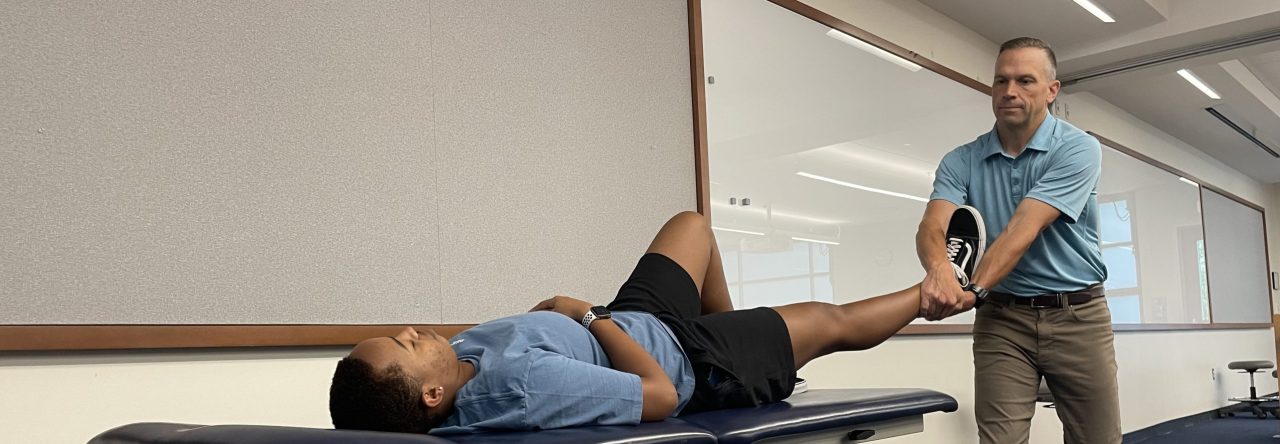Author Names
Bernal-Utrera, C.; Gonzalez-Gerez J,; Anarte-Lazo, E; Rodriguez-Blanco C.
Reviewer Name
Katherine Terkoski SPT
Reviewer Affiliation(s)
Duke University School of Medicine, Doctor of Physical Therapy Division
Paper Abstract
Background Nonspecific chronic neck pain is a fairly common disorder that causes a great impact, and it is greatly influenced by psychosocial factors. Among a number of treatment modalities described for its management, the most common approach is based on manual therapy and specific therapeutic exercise, which have shown a moderate effect on subjects with chronic non-specific neck pain. However, the effect times of these treatments have not been accurately detailed. Our study aims to break down and compare the effects of two experimental treatments based on manual therapy and therapeutic exercise. Methods The short-term and mid-term changes produced by different therapies on subjects with non-specific chronic neck pain were studied. The sample was randomized divided into three groups: manual therapy, therapeutic exercise, and placebo. As dependent variables of our research, we studied (a) pain, based on the visual analog scale and the pressure pain threshold, and (b) cervical disability, through the Neck Disability Index (NDI). Outcomes were registered on week 1, week 4, and week 12. The findings were analyzed statistically considering a 5% significance level (P ≤ 0.05). Results No statistically significant differences (P 0.05) were obtained between the experimental groups, if they exist against the control group. Nonetheless, we found that manual therapy improved perceived pain before than therapeutic exercise, while therapeutic exercise reduced cervical disability before than manual therapy. Effect size (R2) shows medium and large effects for both experimental treatments.Conclusion There are no differences between groups in short and medium terms. Manual therapy achieves a faster reduction in pain perception than therapeutic exercise. Therapeutic exercise reduces disability faster than manual therapy. Clinical improvement could potentially be influenced by central processes.
NIH Risk of Bias Tool
Quality Assessment of Controlled Intervention Studies
- Was the study described as randomized, a randomized trial, a randomized clinical trial, or an RCT
- Yes
- Was the method of randomization adequate (i.e., use of randomly generated assignment)?
- Yes
- Was the treatment allocation concealed (so that assignments could not be predicted)?
- No
- Were study participants and providers blinded to treatment group assignment?
- No
- Were the people assessing the outcomes blinded to the participants’ group assignments?
- No
- Were the groups similar at baseline on important characteristics that could affect outcomes (e.g., demographics, risk factors, co-morbid conditions)?
- Yes
- Was the overall drop-out rate from the study at endpoint 20% or lower of the number allocated to treatment?
- Yes
- Was the differential drop-out rate (between treatment groups) at endpoint 15 percentage points or lower?
- Yes
- Was there high adherence to the intervention protocols for each treatment group?
- Yes
- Were other interventions avoided or similar in the groups (e.g., similar background treatments)?
- Yes
- Were outcomes assessed using valid and reliable measures, implemented consistently across all study participants?
- Yes
- Did the authors report that the sample size was sufficiently large to be able to detect a difference in the main outcome between groups with at least 80% power?
- Cannot Determine, Not Reported, or Not Applicable
- Were outcomes reported or subgroups analyzed prespecified (i.e., identified before analyses were conducted)?
- Cannot Determine, Not Reported, or Not Applicable
- Were all randomized participants analyzed in the group to which they were originally assigned, i.e., did they use an intention-to-treat analysis?
- Yes
Key Finding #1
There were no significant differences between experimental groups.
Key Finding #2
Manual therapy improved perceived pain before therapeutic exercise.
Key Finding #3
Therapeutic exercise reduced cervical disability before manual therapy.
Please provide your summary of the paper
This study aimed to investigate the effects of manual therapy and therapeutic exercise on nonspecific chronic neck pain. The sample was randomized into three groups: manual therapy, therapeutic exercise, and placebo. Dependent variables included pain (visual analog scale and pressure pain threshold) and cervical disability (neck disability index). Outcomes were reported on weeks 1, 4, and 12. There was no statistically significant differences between experimental groups but there were against the control group. Results showed that manual therapy improved perceived pain quicker while therapeutic exercise reduced cervical disability quicker. Effect size showed medium and large effects for both experimental treatments.
Please provide your clinical interpretation of this paper. Include how this study may impact clinical practice and how the results can be implemented.
The study found significant changes with respect to the control group, but no changes between experimental groups. They found that the experimental groups were effective in different ways, indicating a need for combining the two in treatment protocols moving forward. Two things missing from the article were an experimental group combining manual therapy and exercise as well as a follow up with the subjects long term. My key takeaway from the article is that manual therapy can be effective in increasing patient buy-in, which may increase the patient’s willingness to participate in other interventions such as therapeutic exercise. A combination of these interventions appears to be most beneficial, but more research is needed to investigate this concept as well as its effects over time.
